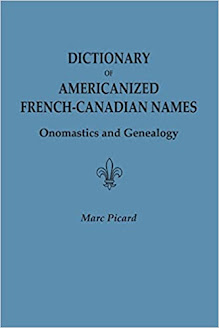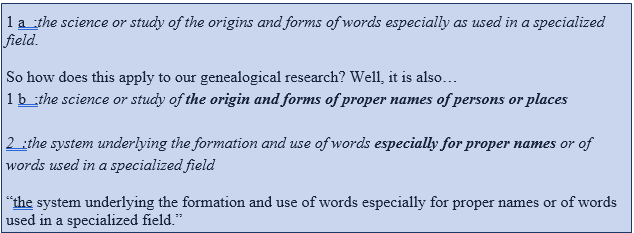
Names - Are you Ignoring Clues?
Many genealogists take for granted that there are naming
conventions amongst the Irish, the Swedish, the Germans, etc. Yet, each may be unique. And, other cultures, countries, communities, may practice differing naming conventions.
Irish:
First
son usually named for the father's father
Second
son usually named for the mother's father
Third
son usually named for the father
Fourth
son usually named for the father's eldest brother
Fifth
son usually named for the mother's eldest brother
First
daughter usually named for the mother's mother
Second daughter usually
named for the father's mother
Third daughter usually
named for the mother
Fourth
daughter usually named for the mother's eldest sister
Fifth daughter usually named for the
father's eldest sister
These naming patterns are guideline. Although often practiced, they were not required. And based on the ancestor's origin, and timeframe, other naming practices may be uncovered.
 |
Figure 2 Text by A. Beider - iijg.org |
Less helpful in tracing a family name would be the patronymic based naming patterns as seen in many early European countries, prior to “familiar surnames” This naming convention causes quite a bit of chaos if the family is not cohesive. An example: John the son of Peter was John Peterson; and John’s son Niel, was Niel Johnson. New surnames were created generationally.
Where to Find Traditional Naming Patterns
Researchers may
wish to use the following to assist in identifying Old Naming Patterns. If your ancestors were traditional, knowing naming patterns could cut hours off your research. However, remember these patterns were generalizations;
not regulated.
When the a3Genelaogy
team researchers are stuck with associating naming with language and culture, we turn to the
work of Albion’s Seed by David Hackett Fischer.
 |
Chart from Martha Wallace Santa Cruz Handout 2014
Martha Wallace 2014 Onomastics – Using Naming Patterns in Genealogy Santa Cruz Handout has more examples and charts, as below:
Her Santa Cruz handout also proffers a variety of resources.
Other Resources
In genealogy we may reference academic papers:
 |
| Article by K. Van Landuyt, 1995 |
The following are a few resources in the a3Genealogy library shelves.
Behind the Name, Mike Campbell
Naming
Patterns & Your Genealogy, Arlene Eakle
Dictionary
of Americanized French-Canadian Names: Onomastics and Genealogy,
Marc Picard
The
Jewish Journey – A Passage Through European History, Edward Gelles
Our current project is uncovering a1709, French Canadian family who settled in the Nebraska Territory. Onomastics has assisted the researchers in mapping the migratory path. Yet, so much work is still needed.
Be Historically Correct
Kathleen Brandt
a3genealogy.com
Accurate Accessible Answers
a3genealogy@gmail.com




No comments:
Post a Comment